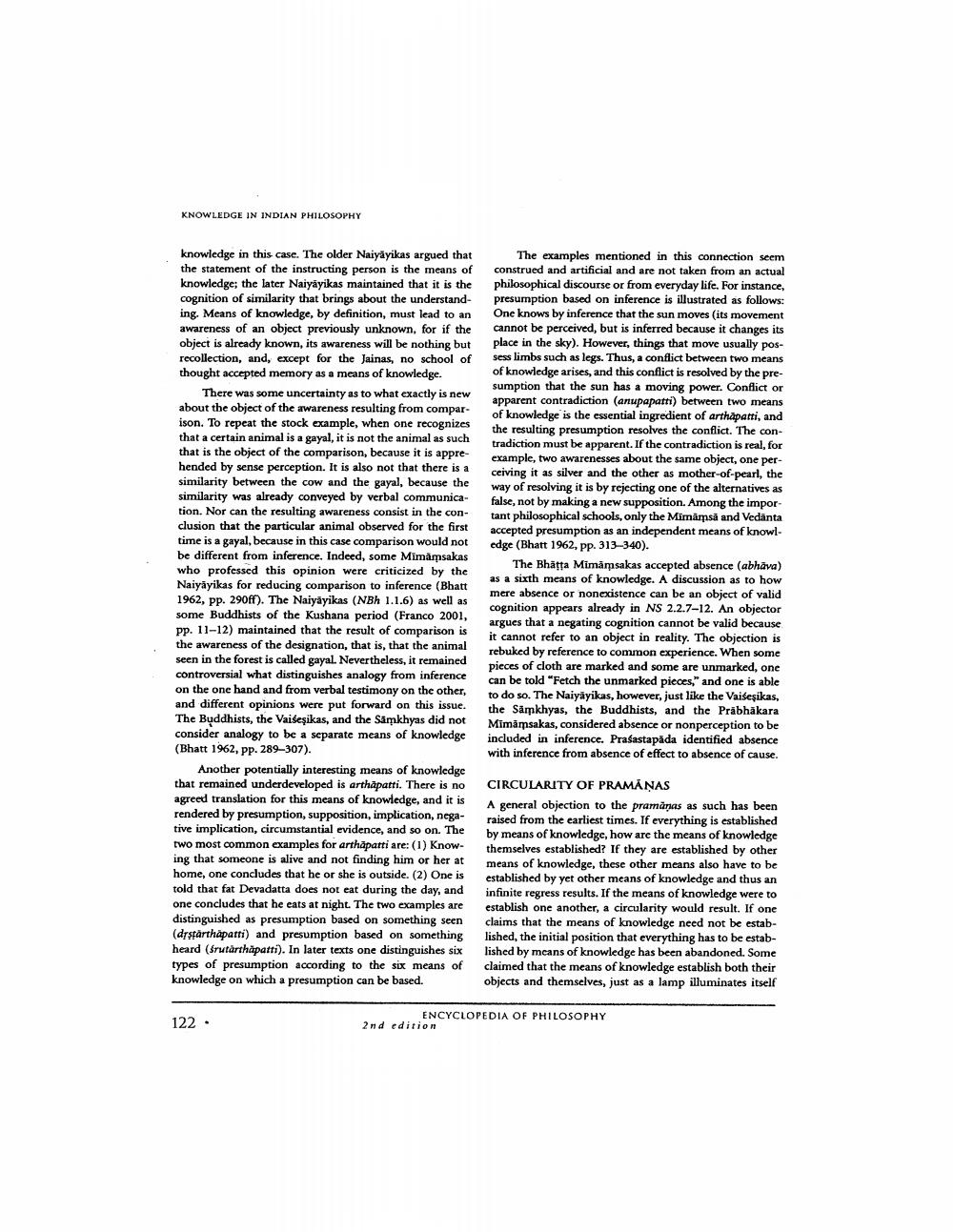Book Title: Knowledge In Indian Philosophy Author(s): Publisher: View full book textPage 8
________________ KNOWLEDGE IN INDIAN PHILOSOPHY knowledge in this case. The older Naiyayikas argued that the statement of the instructing person is the means of knowledge; the later Naiyayikas maintained that it is the cognition of similarity that brings about the understanding. Means of knowledge, by definition, must lead to an awareness of an object previously unknown, for if the object is already known, its awareness will be nothing but recollection, and, except for the Jainas, no school of for the lainas. po school of thought accepted memory as a means of knowledge. There was some uncertainty as to what exactly is new about the object of the awareness resulting from comparison. To repeat the stock example, when one recognizes that a certain animal is a gayal, it is not the animal as such that is the object of the comparison, because it is apprehended by sense perception. It is also not that there is a similarity between the cow and the gayal, because the similarity was already conveyed by verbal communication. Nor can the resulting awareness consist in the conclusion that the particular animal observed for the first time is a gayal, because in this case comparison would not be different from inference. Indeed, some Mimansakas who professed this opinion were criticized by the Naiyayikas for reducing comparison to inference (Bhatt 1962, pp. 290ff). The Naiyayikas (NBh 1.1.6) as well as some Buddhists of the Kushana period (Franco 2001, pp. 11-12) maintained that the result of comparison is the awareness of the designation, that is, that the animal seen in the forest is called gayal. Nevertheless, it remained controversial what distinguishes analogy from inference on the one hand and from verbal testimony on the other, and different opinions were put forward on this issue. The Buddhists, the Vaisesikas, and the Samkhyas did not consider analogy to be a separate means of knowledge (Bhatt 1962, pp. 289-307). Another potentially interesting means of knowledge that remained underdeveloped is arthapatti. There is no agreed translation for this means of knowledge, and it is rendered by presumption, supposition, implication, negative implication, circumstantial evidence, and so on. The two most common examples for arthapatti are: (1) Knowing that someone is alive and not finding him or her at home, one concludes that he or she is outside. (2) One is told that fat Devadatta does not eat during the day, and one concludes that he eats at night. The two examples are distinguished as presumption based on something seen (dpstarthapatti) and presumption based on something heard (srutarthapatti). In later texts one distinguishes six types of presumption according to the six means of knowledge on which a presumption can be based. The examples mentioned in this connection seem construed and artificial and are not taken from an actual philosophical discourse or from everyday life. For instance, presumption based on inference is illustrated as follows: One knows by inference that the sun moves (its movement cannot be perceived, but is inferred because it changes its place in the sky). However, things that move usually possess limbs such as legs. Thus, a conflict between two means of knowledge arises, and this conflict is resolved by the presumption that the sun has a moving power. Conflict or apparent contradiction (anupapatti) between two means of knowledge is the essential ingredient of arthapatti, and the resulting presumption resolves the conflict. The contradiction must be apparent. If the contradiction is real, for example, two awarenesses about the same object, one perceiving it as silver and the other as mother-of-pearl, the way of resolving it is by rejecting one of the alternatives as false, not by making a new supposition. Among the important philosophical schools, only the Mamamsa and Vedanta accepted presumption as an independent means of knowledge (Bhatt 1962, pp. 313-340). The Bhatta Mimansakas accepted absence (abhava) as a sixth means of knowledge. A discussion as to how mere absence or nonexistence can be an object of valid cognition appears already in NS 2.2.7-12. An objector argues that a negating cognition cannot be valid because it cannot refer to an object in reality. The objection is rebuked by reference to common experience. When some pieces of cloth are marked and some are unmarked, one can be told "Fetch the unmarked pieces," and one is able to do so. The Naiyayikas, however, just like the Vaisesikas, the Samkhyas, the Buddhists, and the Prabhakara Mimamsakas, considered absence or nonperception to be included in inference. Prasastapada identified absence with inference from absence of effect to absence of cause. CIRCULARITY OF PRAMANAS A general objection to the pramanas as such has been raised from the earliest times. If everything is established by means of knowledge, how are the means of knowledge themselves established? If they are established by other means of knowledge, these other means also have to be established by yet other means of knowledge and thus an infinite regress results. If the means of knowledge were to establish one another, a circularity would result. If one claims that the means of knowledge need not be established, the initial position that everything has to be established by means of knowledge has been abandoned. Some claimed that the means of knowledge establish both their objects and themselves, just as a lamp illuminates itself 122 ENCYCLOPEDIA OF PHILOSOPHY 2nd editionPage Navigation
1 ... 6 7 8 9
